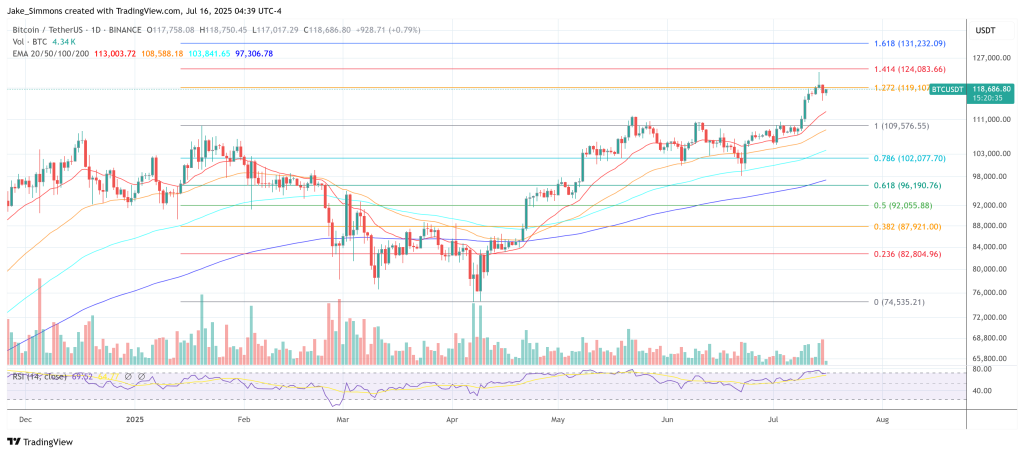ARTICLE AD BOX
A provocative post published on July 14 by long‑time Bitcoin advocate and “Taproot Wizard” Udi Wertheimer has ignited fresh debate over whether the cryptocurrency is on the cusp of what he calls a “generational run the likes of which we’ve never seen.”
Bitcoin’s Generational Run
Writing on X, Wertheimer contends that Bitcoin is emerging from a rare “rotation” in which early, price‑sensitive holders have surrendered their coins to newcomers—chiefly exchange‑traded‑fund investors, corporate treasuries and even nation‑states—who are largely indifferent to the unit price. “Many, if not most, of old big holders have rotated out of the asset,” he asserted, adding that once such rotations succeed, “what follows is a rally in multiples previously considered unimaginable.”
Wertheimer frames his case through an exhaustive retrospective on Dogecoin’s 2019–2021 ascent, arguing that Bitcoin now occupies an analogous position. He recounts how an April 2019 tweet by Elon Musk (“dogecoin might be my favorite cryptocurrency”) triggered an initial 50 percent spike that lulled veteran traders into distributing their bags, only for TikTok‑driven retail inflows to drive the meme coin from roughly $0.0025 to nearly $1 within two years. “Crypto natives thought they knew it was a huge deal, but they underestimated it BY A LOT,” he wrote, describing the move as “the first dogecoin mindfuck,” followed by an even larger “second mindfuck” once legacy sellers exhausted their supply.
Transposing that template onto Bitcoin, Wertheimer insists that “the real move didn’t even start yet.” He claims that traditional capital‑market participants—embodied for him by BlackRock’s iShares Bitcoin ETF (ticker: IBIT) and Michael Saylor’s MicroStrategy—are blind to earlier cycle highs because they measure performance from the January 2024 ETF launch or in dollar‑notional terms, respectively. Referencing IBIT price surge from $30 to $70, Wertheimer says: “‘It’s only up $40! That’s nothing! Why not $700?’ […] They’re completely insensitive to the bitcoin price,” he adds of treasury‑based buyers, arguing that such entities simply “shove as many dollars as they can.”
On price targets, Wertheimer is explicit: “I have a high degree of confidence that we’ll see $400k by the end of this year. This target might be too conservative.” He further predicts an additional order‑of‑magnitude revaluation once “the entire world starts to believe,” echoing Dogecoin’s second‑wave frenzy. “We’re just entering the first mindfuck,” he writes.
The thread reserves particular ire for competing crypto assets. “Your altcoins are fucked,” Wertheimer declares, suggesting that short‑lived spurts of outperformance will not match the “sheer amount of capital flowing into bitcoin.” He singles out Ethereum as “the biggest loser of the cycle,” forecasting that MicroStrategy’s equity capitalisation could surpass Ether’s market value and arguing that persistent selling by “old bagholders” will cap any relative rally. “ETH/BTC will continue to print lower highs,” he predicts, adding that incoming treasury‑style buyers would need “years” to absorb legacy supply before Ethereum can stage a true breakout.
In a direct call to action, Wertheimer tells readers that “you will actually be able to retire off of 1 bitcoin,” urging immediate accumulation and warning that waiting for price dips is futile now that “old holders are out.” He closes with a plea stark in its simplicity: “Wall Street is buying all of the bitcoins … please buy some bitcoin before there isn’t any left.”
Wertheimer’s thesis hinges on the notion that seller‑exhaustion dynamics proven in a small‑cap meme coin can translate, mutatis mutandis, to Bitcoin’s vastly larger market. Whether that analogy holds will be tested in the months ahead; for now, his post has sharpened the fault line between long‑term Bitcoin maximalists and a broader crypto community still weighing the merits—and risks—of what he calls “the first mind‑fuck” of a potentially epoch‑defining rally.
At press time, BTC traded at $118,686.

.png)
 11 hours ago
1
11 hours ago
1








 English (US)
English (US)